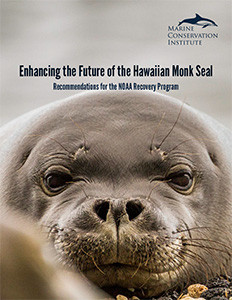Recent Publications
Chandler, W., E. Douce, K. Shugart-Schmidt, T. Watson, M. Sproat, F. Rosenstiel, K. Yentes, X. Escovar-Fadul, and T. Laubenstein. 2015. Enhancing the future of the Hawaiian monk seal: recommendations for the NOAA recovery program. Marine Conservation Institute. Seattle, WA: 1-80. [PDF 4.3MB]
Executive Summary
 Marine Conservation Institute undertook this report on the Hawaiian Monk Seal Recovery Program for the purpose of enhancing the conservation prospects of one of the world’s most endangered pinnipeds. The Hawaiian monk seal (Neomonachus schauinslandi), whose estimated population now hovers between 900 and 1,100 animals, has suffered a 60-year decline despite the efforts of National Oceanic and Atmospheric Administration’s (NOAA) National Marine Fisheries Service (NMFS) and others to reverse it. Although some may view the seal’s fate as hopeless, it is not. Despite difficult circumstances, NMFS and its partners have made progress on several fronts to slow the seal’s decline. Encouragingly, NMFS estimates that up to 32 per cent of all seals living in 2012 were alive because of hundreds of interventions taken by the agency over many years to enhance the survival of individual seals at risk.
Marine Conservation Institute undertook this report on the Hawaiian Monk Seal Recovery Program for the purpose of enhancing the conservation prospects of one of the world’s most endangered pinnipeds. The Hawaiian monk seal (Neomonachus schauinslandi), whose estimated population now hovers between 900 and 1,100 animals, has suffered a 60-year decline despite the efforts of National Oceanic and Atmospheric Administration’s (NOAA) National Marine Fisheries Service (NMFS) and others to reverse it. Although some may view the seal’s fate as hopeless, it is not. Despite difficult circumstances, NMFS and its partners have made progress on several fronts to slow the seal’s decline. Encouragingly, NMFS estimates that up to 32 per cent of all seals living in 2012 were alive because of hundreds of interventions taken by the agency over many years to enhance the survival of individual seals at risk.
Nevertheless, the recovery program faces several challenges that must be met if the program is going to meet its current long term goal of having a population of 3,200 seals, with 500 individuals in the main Hawaiian Islands (MHI) and 2,900 in the Northwestern Hawaiian Islands (NWHI). With a good strategy, sufficient resources, and effective coordination among its several partners, we think NMFS can accelerate progress toward achieving and maintaining a healthy population of monk seals. But it is not going to be easy.
